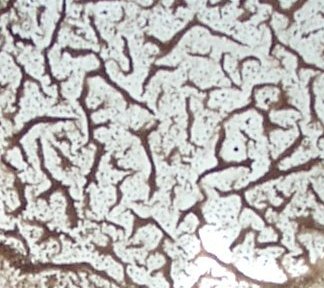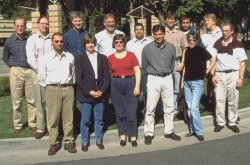Other Research Interests
Assessing Resource Requirements for Geo-Engineering
Options
We are looking rigorously at the fundamental feasibility from a Chemical and
Process Engineering perspective. We are currently calculating the mass and energy
balances for the proposed chemically oriented processes for removing atmospheric
carbon dioxide. We will then move on to process modelling and the generation
of robust metrics and indicators to assess geo-engineering options more generally.
Self-Organising
Particle Films
 We
are creating and studying patterns formed by thin films of powdered materials.
The patterns are fractal, but the mechanism of their formation is unclear. We
have a bench-scale rig to record video of the pattern formation and to determine
"phase diagrams" of trial systems.
We
are creating and studying patterns formed by thin films of powdered materials.
The patterns are fractal, but the mechanism of their formation is unclear. We
have a bench-scale rig to record video of the pattern formation and to determine
"phase diagrams" of trial systems.
One possible application might be pan granulation. This is a technique used
to manufacture some pharmaceutical (and other) pellets, but is a poorly understood
process. A prototype device has shown that intricate patterns form on the bottom
of the pan from wet powder deposits.
The Strategy and Structure of Chemical
Engineering
Many industrialists and academics now hold the perception that the USA has
advanced further and faster than the UK in its academic research and postgraduate
engineering education. They believe that this has led the US to be able to serve
t he needs of
emerging industries more flexibly than the UK. As a by-product of this change,
some in the UK argue that the USA is now less capable of serving the research
needs of the more traditional industries on which such a large proportion of
the economy currently depends.
he needs of
emerging industries more flexibly than the UK. As a by-product of this change,
some in the UK argue that the USA is now less capable of serving the research
needs of the more traditional industries on which such a large proportion of
the economy currently depends.
John Howell and I led a team of 15 younger academic chemical engineers to the
USA in late 1998 to see first-hand how the systems differed and whether there
were particularly useful lessons for us to take from the USA. We visited 21
of the best-ranked departments and studied the attitudes and policies of various
funding agencies - interviewing overall some 250 academics and funding managers.
We gained a view of their best practice, and a reliable insight into why and
how their system had changed over the past decade. Our full report gives much
greater detail and analysis than we provide here. In addition, the face-to-face
interviews were followed up by a questionnaire to gather numerical data. Whilst
we were only looking at chemical engineering departments, it was clear to us
that many of our observations were applicable any science or engineering discipline.
The UK EPSRC and a number of US departments are taking up many of our recommendations.
Publications:
C.J Axon, and J.A. Howell (2001), "Interdisciplinary Research is not Natural
- and It's Not Easy", Ingenia, 1, pp46.
C.J Axon, and J.A. Howell (2001), "It's Not What you do, it's Why you
do it, that Makes he Difference Between Engineering and Science", Proc.
Instn. Mech. Engrs, 215, Part E, pp93.
C.J Axon, and J.A. Howell (2000), "New Industries, New Research, New Education:
A View of the US from the UK", AIChE Annual Meeting, Los Angeles.
J.A. Howell, C.J. Axon, et al (1999), "Changing
the Culture - A Report to the EPSRC on the Strategy and Structure of Chemical
Engineering Research in the USA"
Functional Analysis
for Decommissioning
Designing ways to decommission industrial-scale plant is often difficult and
expensive. It is not often clear which logical pathway to take or whether there
are hidden problems ahead. By analysing the plant, equipment and their constituent
parts in terms of their abstract function we hope to demonstrate that this type
of approach offers insights into the design of decommissioning sequences, leading
to a quicker, environmentally cleaner, cheaper, and more efficient solutions.
In collaboration with David Hicks, I am working on pilot-scale studies to investigate
whether this approach will prove to be a useful tool, particularly when considering
the eventual decommissioning at the initial design stage. The approach we are
using is functional block diagramming. In this way we are also investigating
the effect of human perspective on functionality, in addition to how function
changes with time.
Home
 We
are creating and studying patterns formed by thin films of powdered materials.
The patterns are fractal, but the mechanism of their formation is unclear. We
have a bench-scale rig to record video of the pattern formation and to determine
"phase diagrams" of trial systems.
We
are creating and studying patterns formed by thin films of powdered materials.
The patterns are fractal, but the mechanism of their formation is unclear. We
have a bench-scale rig to record video of the pattern formation and to determine
"phase diagrams" of trial systems. he needs of
emerging industries more flexibly than the UK. As a by-product of this change,
some in the UK argue that the USA is now less capable of serving the research
needs of the more traditional industries on which such a large proportion of
the economy currently depends.
he needs of
emerging industries more flexibly than the UK. As a by-product of this change,
some in the UK argue that the USA is now less capable of serving the research
needs of the more traditional industries on which such a large proportion of
the economy currently depends.